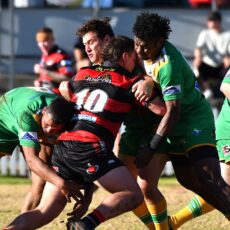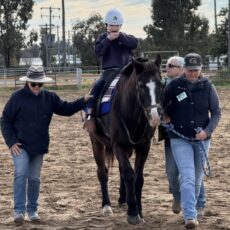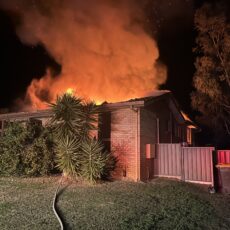When Boggabri lad Roy Stanley McGregor enlisted in 1914 he was 24 years of age, married with an infant son, a doctor with just two years of medical experience – and no experience of war.
When he finally came home five years later, he was a highly decorated soldier and medical officer, twice mentioned in despatches, and had been awarded the Distinguished Service Order and the Serbian Order of the White Eagle during his rise to the rank of Lieutenant Colonel.
Roy McGregor initially served as Regimental Medical Officer on Gallipoli and after the evacuation he commanded the 4th Field Ambulance on the Western Front, where he was the officer responsible for the medical forward planning arrangements for the 4th Division in preparation for major battles in France and Belgium. Later in the war, he was responsible for the medical arrangements and transport home for thousands of wounded and convalescent men at the Sutton Veny depot and hospital in southern England.
Roy Stanley McGregor was also the Australian medical officer who took a forward role in a temporary armistice on Gallipoli in late May 1915 which allowed both sides – the Allies and the Turks – to bury their dead after almost a month of fierce fighting.
The rotting dead clogged the trenches on both sides and in no-man’s land and the stench of death was overwhelming. Along the line there were overtures from both sides for a ceasefire to allow the dead to be buried.
The truce was initiated by the action of the then Captain McGregor, who climbed onto a parapet and started waving his arms, hoping that his Red Cross brassard would protect him.
An English-speaking Turkish medical officer emerged from the other side. Captain McGregor and two other men, including a 16th Battalion private who spoke French, talked with the Turkish officer in no-man’s-land. The Turks asked for an armistice of eight hours and Captain McGregor took the request to the quarters of Commander of the Australian forces, John Monash.
When McGregor returned to the scene, he found that the Turkish medical officer had gone. As he tried to speak with the Turkish line, he was told to “get back, get back”. He only just regained the safety of his trenches when a torrent of fire broke out.
Nevertheless, the truce was later negotiated between the high command of both forces on May 24 and burial parties emerged from both trenches. After exchanging cigarettes and even shaking hands and trying to converse, the soldiers began burying hundreds of bodies. When this was done, both sides returned to the trenches and hostilities resumed.
In August the Allies launched a major offensive at places such as Lone Pine, Chunuk Bair, Baby 700 and Hill 971, where daily casualties in battle ran into their thousands. Large numbers of troops were also affected by sickness, through poor sanitation and lack of water and pollution caused by dead and decaying bodies. Captain McGregor also became seriously ill and in early September he was evacuated to Alexandria in Egypt with dysentery and jaundice. He only returned to duty on the Peninsula in mid-November.
By November Allied commanders had accepted the fact that the Gallipoli campaign had been a disaster. With winter coming on and the possibility that extreme weather conditions would restrict movements of the transport fleet — bringing in reinforcements and supplies and taking off the wounded – the decision was taken to end the campaign. The withdrawal was an epic in itself – more than 40,000 Australian troops were taken off under the cover of darkness, with barely a casualty.
There were more than 200,000 Allied casualties in the eight-month Gallipoli campaign, including 8700 Australians who died and close to 50,000 who were wounded or listed as missing.
Captain McGregor was among those evacuated on the second last day, December 19, 1915. Decimated by the toll on Gallipoli, the Australian divisions went to Egypt to train and regroup for the Western Front in France and Belgium. Roy McGregor rejoined the 4th Field Ambulance in France, where the casualty lists were even more horrifying than on Gallipoli. Pitched into battle on the Somme, at Fromelles and Pozieres, where thousands of Australians died each day, soldiers also had to endure a new and frightening weapon of war, chlorine gas. By then promoted to Major, Roy McGregor was appointed Divisional Gas Officer (4th Division), charged with developing strategies and defences against the enemy barrages.
The history of the 5th Battalion offers the following description of conditions on the Somme: “The whole area was one of indescribable desolation. Once a charming countryside … the idyllic landscape had become in a few short months the most loathsome and appalling terrain in the world. A storm of high explosive raged over it night and day. Millions of shells fell in its fields, its woods, its villages. The fields became mere areas of dishevelled rubbish, the shell holes filled with putrid water in which rotted the corpses of men and animals.
“The frames of gun carriages and other vehicles lay everywhere and death lurked for many in the unexploded shells and bombs with which the whole was littered.
“The villages were not merely destroyed.
They were obliterated, scarcely distinguishable from the turgid seas of mud that had once been meadows”.
Major McGregor was mentioned in Sir Douglas Haig’s despatches of November 13, 1916, for gallant and distinguished services in the field. Less than a month later, the White Eagle of Serbia, 4th class with swords, was conferred on him by the King of Serbia.
In September 1917, Major McGregor was awarded the Distinguished Service Order for his “unflagging devotion to duty”. He was again mentioned in Sir Douglas Haig’s despatches in late 1917.
At the end of the year he was promoted to Lieutenant Colonel and appointed Senior Medical Officer at No. 1 Command Depot in England. He was officer-in-charge of a post responsible for the administration and medical arrangements for up to 19,000 sick and wounded Australian soldiers awaiting transport home, as well as a 250-bed hospital.
In June 1918, McGregor rejoined the 4th Field Ambulance in France as commanding officer and was involved in the major Australian operation at Hamel and then in further offensives as the Germans retreated.
When the Germans surrendered, his work, however, was far from completed.
Wounded soldiers still had to be treated and arrangements made for transport home and a vast network of medical services had to be dismantled. It was April 1919 before he could board ship to return home.
After the war, Colonel McGregor was re-appointed to his pre-war position as Resident Medical Superintendent at Perth Children’s Hospital, rejoining his wife Elvina and son Alexander.
He went into private practice in 1922 and in 1926, after divorce, he joined his brother Keith in private practice at Beenleigh in Queensland. He served as Medical Superintendent at Gympie and Maryborough and retired in 1954, though he often worked as a locum.
He died as a locum in Killarney (Queensland) in 1963. His son Alexander was also a doctor, who served in World War II and was later Medical Superintendent at Gladstone Hospital before going into private practice in Toowoomba. He was Mayor of Toowoomba from 1949 to 1952. He died in 1970. Alexander’s son Kent also became a doctor.
This information was originally published in In the Line of Fire, written by Ron McLean.
To order photos from this page click here










